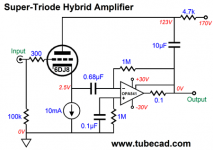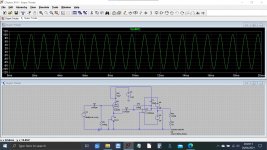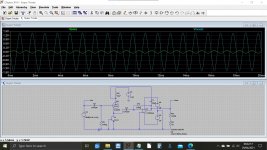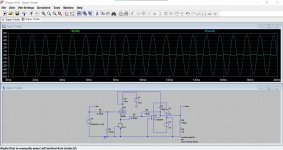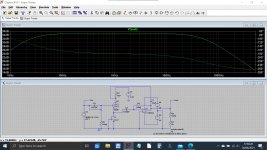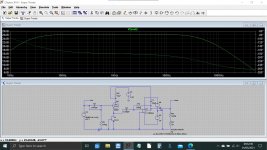Hi,
I am trying add gain at the OPA541 op amp output stage of a hybrid circuit, Broskie’s Super Triode. (More Super-Triode Amplifiers)
Mr. Broskie mentions that he uses 1M resistors for the OPA541 at - feedback and + to ground to keep the dc offset “extra low”. There's no input resistor. I’ve never seen an op amp used in unity gain arranged in this manner.
This is where I get confused. I'm used to simple inverting op amp circuits, with input and feedback resistors.
With this circuit, is NO input resistor needed for unity gain?
What’s the arithmetic for the gain in this circuit?
If I want the OPA541 generate some gain, (say 10x), would I use a 100k input resistor with the 1M feedback resistor?
Does anyone know a resource (webpage or section of a book) that can help me directly understand this use of an op amp to help me figure out adapting these circuits?
Thank you very much - ziffel
I am trying add gain at the OPA541 op amp output stage of a hybrid circuit, Broskie’s Super Triode. (More Super-Triode Amplifiers)
Mr. Broskie mentions that he uses 1M resistors for the OPA541 at - feedback and + to ground to keep the dc offset “extra low”. There's no input resistor. I’ve never seen an op amp used in unity gain arranged in this manner.
This is where I get confused. I'm used to simple inverting op amp circuits, with input and feedback resistors.
With this circuit, is NO input resistor needed for unity gain?
What’s the arithmetic for the gain in this circuit?
If I want the OPA541 generate some gain, (say 10x), would I use a 100k input resistor with the 1M feedback resistor?
Does anyone know a resource (webpage or section of a book) that can help me directly understand this use of an op amp to help me figure out adapting these circuits?
Thank you very much - ziffel
Attachments
Its an intriguing circuit. So intriguing I simulated it.
The opamp must still follow the rules, i.e the output does what is needed to make the difference between the inputs equal zero.
Working backwards, with 100mv applied to the input I get 10 volts at the output and with 180 degree phase shift.
So the circuit has a gain in my test of -100. That implies the transconductance if that is the right word via the valve must be 'equal' to 10k
The gain looks to be hugely dependent then on the valve characteristic itself?
The 1meg feedback resistor effects gain. I tried 500k and 100k and got 9 volt and 3 volt peak output. The 1meg gives 10 volts peak. So not linear as you might expect.
That's as far as I got for tonight
The opamp must still follow the rules, i.e the output does what is needed to make the difference between the inputs equal zero.
Working backwards, with 100mv applied to the input I get 10 volts at the output and with 180 degree phase shift.
So the circuit has a gain in my test of -100. That implies the transconductance if that is the right word via the valve must be 'equal' to 10k
The gain looks to be hugely dependent then on the valve characteristic itself?
The 1meg feedback resistor effects gain. I tried 500k and 100k and got 9 volt and 3 volt peak output. The 1meg gives 10 volts peak. So not linear as you might expect.
That's as far as I got for tonight
Attachments
Thank you, Mooly.
I'm impressed that you simulated the circuit.
I'm not sure about the amp gain of -100. Broskie states on his webpage the following.
"This amplifier's gain will equal the 6DJ8's mu of 33. Moreover, the 6DJ8 will leave its imprint on the solid-state power amplifier's output, which is what super-triode amplifiers are all about. The output impedance proves amazingly low." (More Super-Triode Amplifiers)
I'm impressed that you simulated the circuit.
I'm not sure about the amp gain of -100. Broskie states on his webpage the following.
"This amplifier's gain will equal the 6DJ8's mu of 33. Moreover, the 6DJ8 will leave its imprint on the solid-state power amplifier's output, which is what super-triode amplifiers are all about. The output impedance proves amazingly low." (More Super-Triode Amplifiers)
....The gain looks to be hugely dependent then on the valve characteristic itself?....
The plate-cathode and grid-cathode voltages of an ideal triode are Mu different. Here the cathode feeds a virtual earth, output of that drives the plate, and input drives the grid. To a first approximation the gain will be Mu. To a second approximation it will follow the non-constant value of Mu as we work to extremes of current and voltage.
The triode's guts are a voltage-divider, just like a resistive voltage divider, except as electrostatic field instead of resistance.
You are not seeing a steady "100". Mu is not dead-constant, but I bet you are also driving pretty widely across the V/I plane.
Thanks PRR, I couldn't think of a way of explaining what must be happening.
So lets try a different bottle. Here is a 12AU7. The voltage gain now is just 14.
Thank you, Mooly.
I'm impressed that you simulated the circuit.
I'm not sure about the amp gain of -100. Broskie states on his webpage the following.
"This amplifier's gain will equal the 6DJ8's mu of 33. Moreover, the 6DJ8 will leave its imprint on the solid-state power amplifier's output, which is what super-triode amplifiers are all about. The output impedance proves amazingly low." (More Super-Triode Amplifiers)
So lets try a different bottle. Here is a 12AU7. The voltage gain now is just 14.
Attachments
"This amplifier's gain will equal the 6DJ8's mu of 33. Moreover, the 6DJ8 will leave its imprint on the solid-state power amplifier's output, which is what super-triode amplifiers are all about. The output impedance proves amazingly low." (More Super-Triode Amplifiers)
I've got one of those (models). Lets see.
So the voltage gain comes out at around 55. That sounds pretty close in simulation land to your 33 but I would worry how repeatable a real design would be between different valves.
Attachments
A user named FYC has built a variant using a 6SN7 with very good results. (Super Triode Connected (STC) chip amp)
In your opinion, if I needed to add some gain to this circuit, would I just be able to insert an input resistor?
In your opinion, if I needed to add some gain to this circuit, would I just be able to insert an input resistor?
The overall gain of this STC setup is controlled by the mu of the triode, so 100 for 12AX7, 33 for 6DJ8, and 20 for 6SN7 (in my execution). I do not claim to understand this circuit in full but nevertheless did build one to test. The 1M feedback resistor works in parallel with the triode. The circuit should work even if you do not use this. This impedance is much higher than the triode, so "sonically" is insignificant. But for output DC drift control I added this in my build. The opamp used here must be unity gain stable (OPA541 is one such). I thought about this for quite a while also "why"? My interpretation was that the mu of the triode shown in the datasheet is only a representative figure, at high freq the mu will drop and somewhere it will be close to unity. Hence it is important that when this feedback element force the gain to be 1, the opamp must not oscillate. I do not see you can alter the gain of opa541 to still make a STC circuit. The gain is solely controlled by the mu. Personally I think 6SN7 is very suitable for this application, while 33x for 6DJ8 is already a bit too high.
Just to add 1 more point to the gain issue with OPA541. When I built this, I had an idea that the overall gain must be kept reasonably low to cater for the low gain bandwidth product of this chip, which is 1.6MHz. With 6DJ8 at 33x, the bandwidth will only be 48kHz. By using 6SN7 at 20x, this will improve to about 80kHz.
This is surprising. Unfortunately I am not able to measure my 6SN7 version now as I dismantled it already. As far as I remembered, it was about 18x slightly shy of the theoretical 20x. For 6DJ8, I cannot imagine how this can go upto 56x. In a way, the triode simply does not care about the opamp but only track along the loadline, which is close to a horizontal line when the cathode is loaded with a CCS. Mu is more or less the limit.
Great! Maybe the 6DJ8 you used was not accurate?I have a 6SN7 model and that comes out at 26db which is actually 20x gain. How cool is that
- Home
- Amplifiers
- Chip Amps
- OPA541 in unity gain and 10x gain question
